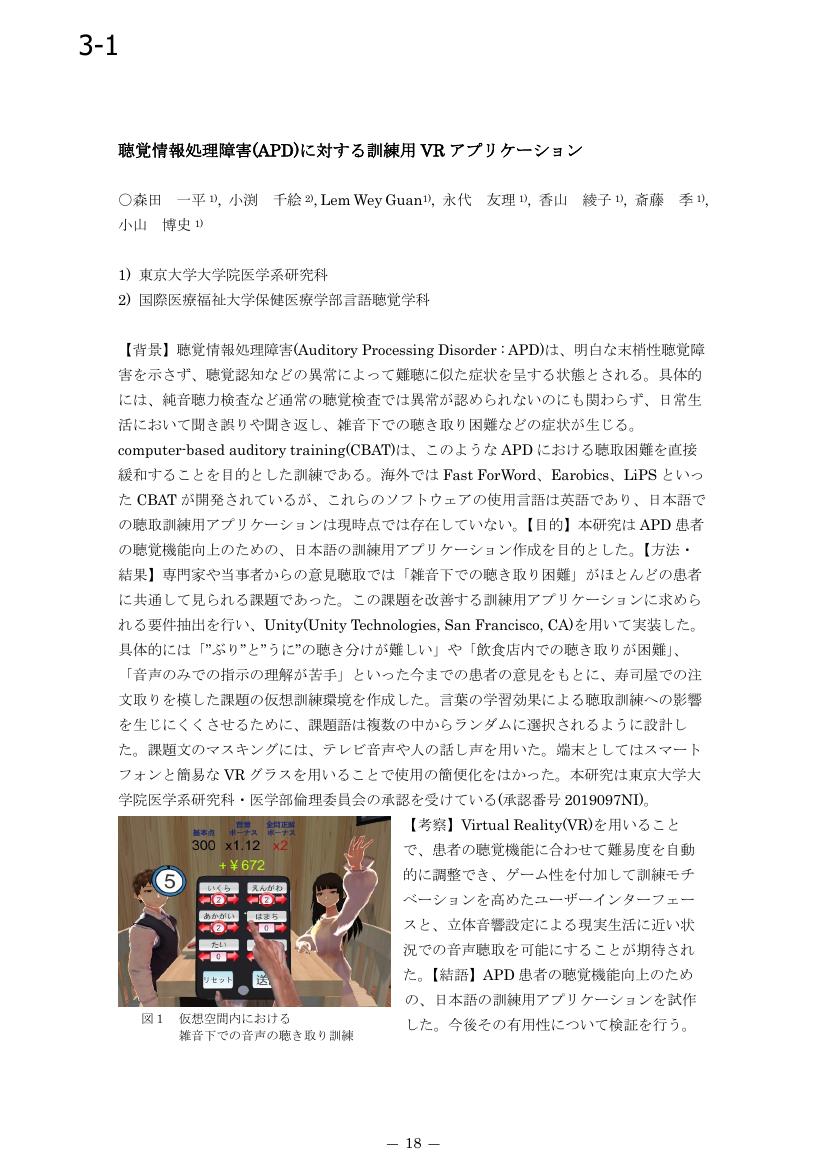8 0 0 0 OA 聴覚情報処理障害(APD)に対する訓練用VRアプリケーション
- 著者
- 森田 一平 小渕 千絵 Lem Wey Guan 永代 友理 香山 綾子 斎藤 季 小山 博史
- 出版者
- 日本VR医学会
- 雑誌
- 日本VR医学会学術大会プログラム・抄録集 第19回 日本VR医学会学術大会 (ISSN:21883491)
- 巻号頁・発行日
- pp.18, 2019 (Released:2020-08-31)
2 0 0 0 OA 看護師の多重課題に関する教育支援用VRアプリケーションの開発
- 著者
- 佐藤 咲樹 リム ウィグァン 永代 友理 斎藤 季 香山 綾子 金井 Pak 雅子 小山 博史
- 出版者
- 日本VR医学会
- 雑誌
- 日本VR医学会学術大会プログラム・抄録集 第19回 日本VR医学会学術大会 (ISSN:21883491)
- 巻号頁・発行日
- pp.23, 2019 (Released:2020-08-31)
- 著者
- 佐藤 咲樹 Lem Wey GUAN 永代 友理 斎藤 季 香山 綾子 柏木 公一 金井Pak 雅子 小山 博史
- 出版者
- 日本VR医学会
- 雑誌
- VR医学 (ISSN:13479342)
- 巻号頁・発行日
- vol.17, no.1, pp.15-22, 2020-12-01 (Released:2021-11-22)
- 参考文献数
- 20
Background: Nurses must make accurate decisions when caring for patients, even when multitasking. A wrong decision may endanger life. Student nurses are responsible only for single patients during their clinical practice. New graduates have minimal experience with multitasking. We developed a virtual reality (VR) multitasking simulation and evaluated its effectiveness. Methods: Student nurses prioritized tasks when caring for patients. We performed a randomized control trial enrolling senior nursing students who were randomly divided into two groups; thus, an interventional group (13 students) and a control group (performing a paper-based exercise; 14 students). The educational outcomes were measured by asking multiple-choice questions. Subjective confidence was assessed using a Visual Analog Scale. Results and Discussion: The educational outcomes did not differ significantly between the two groups. Subjective confidence was significantly higher in the intervention than in the control group. Conclusion: Although the VR simulation did not improve education, it significantly increased subjective confidence.
1 0 0 0 OA 脳動脈瘤クリッピングシミュレータの開発
- 著者
- 庄野 直之 金 太一 斉藤 雄介 斎藤 季 斉藤 延人 小山 博史
- 出版者
- 日本VR医学会
- 雑誌
- VR医学 (ISSN:13479342)
- 巻号頁・発行日
- vol.13, no.1, pp.20-26, 2015-11-10 (Released:2016-11-30)
- 参考文献数
- 17
BACKGROUND: Subarachnoid hemorrhages may occur spontaneously from a ruptured cerebral aneurysm. The placement of clips around the neck of the aneurysm (clipping) is one of the very common surgical treatments. However, clipping is a challenging surgery for most neurosurgeons. To help support the surgeon’s decision-making process and preoperative surgical planning, we developed a VR clipping simulator (ClipSim).METHODS: High definition 3DCG models such as aneurysms, arteries, and brain were segmented by Amira® software (FEI, Hillsboro, OR) and surgical clips were modeled by Maya® software (Autodesk, San Rafael, CA). These models were integrated and simulated into Unity® (Unity Technologies, San Francisco, CA) software.RESULTS: We successfully developed a real-time, interactive, clipping simulator with an aneurysm deformable model used by PhysX real-time physics engine (Ageia, Santa Clara, CA). In conclusion, the simulator may be useful prior to surgery during the surgeon’s decision making process for selecting the most appropriate clips.

